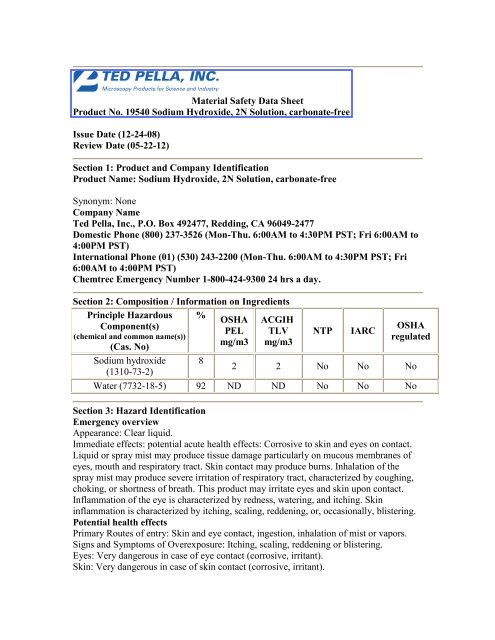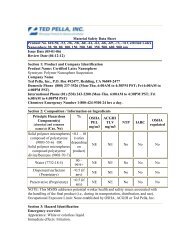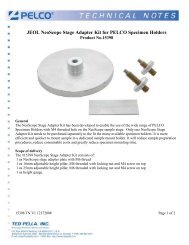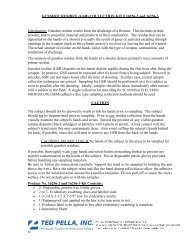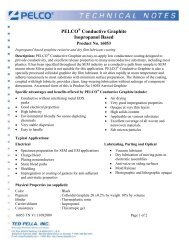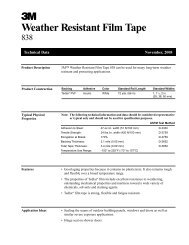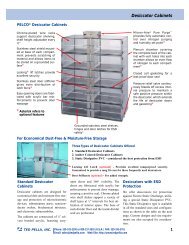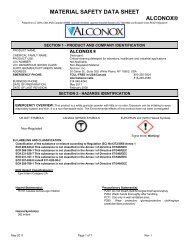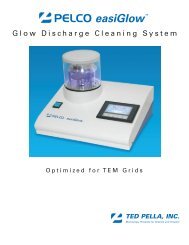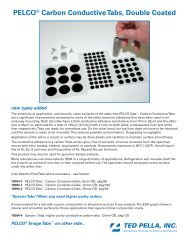Create successful ePaper yourself
Turn your PDF publications into a flip-book with our unique Google optimized e-Paper software.
Material Safety Data SheetProduct No. 19540 Sodium Hydroxide, 2N Solution, carbonate-freeIssue Date (12-24-08)Review Date (05-22-12)Section 1: Product and Company IdentificationProduct Name: Sodium Hydroxide, 2N Solution, carbonate-freeSynonym: NoneCompany Name<strong>Ted</strong> <strong>Pella</strong>, <strong>Inc</strong>., P.O. Box 492477, Redding, CA 96049-2477Domestic Phone (800) 237-3526 (Mon-Thu. 6:00AM to 4:30PM PST; Fri 6:00AM to4:00PM PST)International Phone (01) (530) 243-2200 (Mon-Thu. 6:00AM to 4:30PM PST; Fri6:00AM to 4:00PM PST)Chemtrec Emergency Number 1-800-424-9300 24 hrs a day.Section 2: Composition / Information on IngredientsPrinciple Hazardous %OSHA ACGIHComponent(s)PEL TLV(chemical and common name(s))(Cas. No)mg/m3 mg/m3Sodium hydroxide 8(1310-73-2)NTPIARCOSHAregulated2 2 No No NoWater (7732-18-5) 92 ND ND No No NoSection 3: Hazard IdentificationEmergency overviewAppearance: Clear liquid.Immediate effects: potential acute health effects: Corrosive to skin and eyes on contact.Liquid or spray mist may produce tissue damage particularly on mucous membranes ofeyes, mouth and respiratory tract. Skin contact may produce burns. Inhalation of thespray mist may produce severe irritation of respiratory tract, characterized by coughing,choking, or shortness of breath. This product may irritate eyes and skin upon contact.Inflammation of the eye is characterized by redness, watering, and itching. Skininflammation is characterized by itching, scaling, reddening, or, occasionally, blistering.Potential health effectsPrimary Routes of entry: Skin and eye contact, ingestion, inhalation of mist or vapors.Signs and Symptoms of Overexposure: Itching, scaling, reddening or blistering.Eyes: Very dangerous in case of eye contact (corrosive, irritant).Skin: Very dangerous in case of skin contact (corrosive, irritant).
Ingestion: Very dangerous in case of ingestion (corrosive, irritant). May be fatal ifswallowed. May cause severe and permanent damage to the digestive tract. Causes severegastrointestinal tract irritation and burns. May cause perforation of the digestive tract.Causes severe pain, nausea, vomiting, diarrhea, and shock. May cause corrosion andpermanent destruction of the esophagus and digestive tract (Sodium hydroxide).Inhalation: Slightly dangerous to dangerous in case of inhalation.Chronic Exposure: Repeated or prolonged exposure to spray mist may producerespiratory tract irritation leading to frequent attacks of bronchial infection. Repeatedexposure to a highlytoxic material may produce general deterioration of health by an accumulation in one ormany human organs.Chemical Listed As Carcinogen Or Potential Carcinogen: NoSee Toxicological Information (Section11)Potential environmental effectsSee Ecological Information (Section 12)Section 4: First Aid MeasuresIf accidental overexposure is suspectedEye(s) Contact: Check for and remove any contact lenses. Immediately flush eyes withrunning water for at least 15 minutes, keeping eyelids open. Cold water may be used. Getmedical attention immediately.Skin Contact: In case of contact, immediately flush skin with plenty of water for at least15 minutes while removing contaminated clothing and shoes. Cover the irritated skinwith an emollient. Cold water may be used. Wash clothing before reuse. Thoroughlyclean shoes before reuse. Get medical attention immediately. Serious contact: Wash witha disinfectant soap and cover the contaminated skin with an anti-bacterial cream. Seekimmediate medical attention.Inhalation: If inhaled, remove to fresh air. If not breathing, give artificial respiration. Ifbreathing is difficult, give oxygen. Get medical attention immediately.Ingestion: If swallowed, do not induce vomiting unless directed to do so by medicalpersonnel. Never give anything by mouth to an unconscious person. Loosen tight clothingsuch as a collar, tie, belt or waistband. Get medical attention immediately.Note to physicianTreatment: NDMedical Conditions generally Aggravated by Exposure: NDSection 5: Fire Fighting MeasuresFlash Point: NAFlammable Limits: NAAuto-ignition point: NAFire Extinguishing Media: NASpecial Fire Fighting Procedures: NIFUnusual Fire and Explosion Hazards: Non-explosive in presence of open flames andsparks, of shocks.Hazardous combustion products: NADOT Class: Corrosive.
Section 6: Accidental Release MeasuresSteps to be Taken in Case Material is Released or Spilled: Small Spill: Dilute with waterand mop up, or absorb with an inert dry material and place in an appropriate wastedisposal container. Ifnecessary: Neutralize the residue with a dilute solution of acetic acid. Large Spill:Corrosive liquid. Poisonous liquid. Stop leak if without risk. Absorb with dry earth, sandor other non-combustible material. Do not get water inside container. Do not touchspilled material. Use water spray curtain to divert vapor drift. Use water spray to reducevapors. Prevent entry into sewers, basements or confined areas; dike if needed. Call forassistance on disposal. Neutralize the residue with a dilute solution of acetic acid. Becareful that the product is not present at a concentration level above TLV. Check TLV onthe <strong>MSDS</strong> and with local authorities.Waste Disposal Methods: Dispose of waste according to Federal, State and LocalRegulations.Section 7: Handling and StoragePrecautions to be taken in Handling and Storage: Store in original plastic container. Keepcontainer tightly closed. Keep locked up. Keep container dry. Do not ingest. Do notbreathe gas/fumes/ vapor/spray. Never add water to this product (can produce extremeheat). In case of insufficient ventilation, wear suitable respiratory equipment. If ingested,seek medical advice immediately and show the container or the label. Avoid contact withskin and eyes. Keep away from incompatibles such as metals.Storage temperature: Keep container in a cool, well-ventilated area.Storage Pressure: NASection 8: Exposure Controls / Personal ProtectionEngineering ControlsVentilation required: Provide exhaust ventilation or other engineering controls to keepthe airborne concentrations of vapors below their respective threshold limit value.Personal Protection EquipmentRespiratory protection: Vapor respirator. Be sure to use an approved/certified respiratoror equivalent.Protective gloves: Wear chemical impervious glovesSkin protection: Face Shield, protective impervious full suit, rubber boots.Eye protection: Face ShieldAdditional clothing and/or equipment: Shower and eye wash station. A self containedbreathing apparatus should be used to avoid inhalation of the product. Suggestedprotectiveclothing might not be sufficient; consult a specialist before handling this product.Exposure GuidelinesSee Composition/Information on Ingredients (Section2)Section 9 Physical and Chemical PropertiesAppearance and Physical State: Clear colorless liquid.Odor (threshold): Odorless.
Specific Gravity (H2O=1): 1.04Vapor Pressure (mm Hg): 17.535 mm of Hg (@20oC) based on data for: WaterVapor Density (air=1): 0.62 (Air = 1) based on data for: Water.Percent Volatile by volume:Evaporation Rate (butyl acetate=1):Boiling Point: The lowest known value is 100°C (212°F) (Water).Freezing point / melting point: NDpH: Basic or Alkaline.Solubility in Water: Easily soluble in cold water, hot water.Molecular Weight: Sodium Hydroxide: 40 g/moleSection 10: Stability and ReactivityStability: Stable under normal conditions. Keep lid tight.Conditions to Avoid: <strong>Inc</strong>ompatible materials. Hygroscopic.Materials to Avoid (<strong>Inc</strong>ompatibility): Very slightly too slightly corrosive in presence ofglass. Reactive with metals. Slightly reactive to reactive with oxidizing agents, reducingagents, acids, alkalis.Hazardous Decomposition Products: NAHazardous Polymerization: Will not occur.Section 11: Toxicological InformationResults of component toxicity test performed: Sodium hydroxide (1310-73-2): IDLH, 10mg/m3. Lowest published human lethal oral dose, 1.57 mg/kg of body weight.Human experience: May affect genetic material. Investigation as a mutagen (cytogeneticanalysis) (Sodium hydroxide)This product does not contain any compounds listed by NTP or IARC or regulated byOSHA as a carcinogen.Section 12: Ecological InformationEcological Information: NDChemical Fate Information: NDSection 13 Disposal ConsiderationsRCRA 40 CFR 261 Classification: NDFederal, State and local laws governing disposal of materials can differ. Ensure properdisposal compliance with proper authorities before disposal.Section 14: Transportation InformationUS DOT Information: Proper shipping name: Sodium hydroxide, solution (Sodiumhydroxide)Hazard Class: 8Packaging group: IIUN Number: UN1824IATA: Proper shipping name: Sodium hydroxide, solution (Sodium hydroxide)Hazard Class: 8
Packing group: IIUN Number: UN1824IMO: Proper shipping name: Sodium hydroxide, solution (Sodium hydroxide)Class: 8UN Number: UN1824Packing group: IIMarine Pollutant:Canadian TDG: Sodium hydroxide, solution (Sodium hydroxide)Section 15: Regulatory InformationUnited States Federal Regulations<strong>MSDS</strong> complies with OSHA’s Hazard Communication Rule 29, CFR 1910.1200.SARA: NDSARA Title III:RCRA: NDTSCA: Sodium hydroxide TSCA 8(b) inventory:CERCLA: Hazardous substances: Sodium hydroxide (1310-73-2): RQ = 1000 lbs. (453.6kg)State RegulationsCalifornia Proposition 65: NoInternational RegulationsCanada WHMIS: Class D-2A: Material causing other toxic effects (Very Toxic). Class E:Corrosive liquid.Europe EINECS Numbers:Section 16: Other InformationLabel Information: Corrosive, ToxicEuropean Risk and Safety Phrases: R35-Causes severe burns. R42-May causesensitization by inhalation. R36/37/38-Irritating to eyes, respiratory system and skin.European symbols needed: NDCanadian WHMIS Symbols: NDHMIS® Hazard Rating: Health: 3; Flammability: 0; Physical Hazard: 0; PersonalProtection: JNFPA Hazard Rating: Health: 3; Flammability: 0; Instability: 0; Special Hazards ALKGloves. Full suit. Vapor respirator. Be sure to use an approved/certified respirator orequivalent. Face shield(0=least, 1=Slight, 2=Moderate, 3=High, 4=Extreme)Abbreviations used in this documentNE= Not establishedNA= Not applicableNIF= No Information FoundND= No DataDisclaimer<strong>Ted</strong> <strong>Pella</strong>, <strong>Inc</strong>. makes no warranty of any kind regarding the information furnishedherein. Users should independently determine the suitability and completeness of
information from all sources. While this data is presented in good faith and believed to beaccurate, it should be considered only as a supplement to other information gathered bythe user. It is the User's responsibility to assure the proper use and disposal of thesematerials as well as the safety and health of all personnel who may work with orotherwise come in contact with these materials.<strong>MSDS</strong> Form 0013F1 V2


